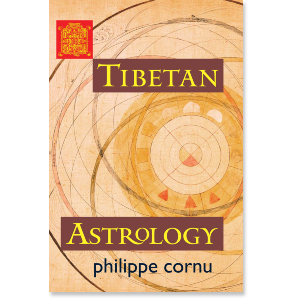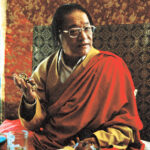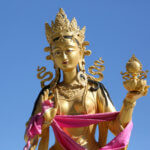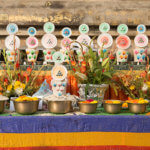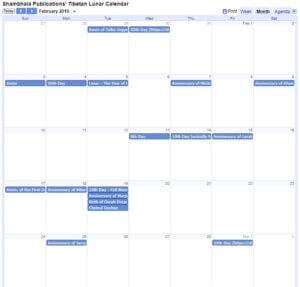An excerpt from Tibetan Astrology, where Phillipe Cornu summarizes Kyabje Dudjom Rinpoche's explanation of each month's 10th day, or Guru Rinpoche Day.
The 10th is Guru Rinpoche day. Guru Rinpoche or Padmasambhava is the Buddha who established Tantric Buddhism in Tibet. At the esoteric level, he is the essence of all buddhas and masters. He is the Buddha of our troubled age, dispelling all negativities, and as such he occupies an important place in the hearts and in the practice of the Tibetans, particularly those of the Nyingma school.
Each Guru Rinpoche day commemorates an episode from his life. His Holiness Dudjom Rinpoche, late Supreme Head of the Nyingma School, describes these as follows.
1st month: Guru Rinpoche renounces his kingdom and practices yoga and meditation in the great creation ground of Sitavana, the "cool grove," where he attains liberation. He gathers around himself the goddesses of the cemeteries, the matrikas and dakinis, and is known as Śantarakśita, "the protector of peace."
2nd month: Guru Rinpoche receives monastic ordination (rabjung) from Ananda, a disciple of the Buddha. Displaying an unparalleled comprehension and complete mastery both of the sutras and of the tantras, he is known as Śakya Senge, "Lion of the Sakyas."

4th month: The deluded ministers and people of Orgyen (Oddiyana) attempt to burn Guru Rinpoche and his consort Mandarava alive. The guru transforms the flames into a lake, from which he emerges with his consort seated on a lotus. The king, his ministers, and the people are filled with devotion. I le is known as Pema Dorje Tsel, "the Guru with Vajra and Lotus."
5th month: The Tirthikas, extreme philosophers, try to damage the Dharma in South India; but through his great power, Guru Rinpoche defeats them all along with their gods and protectors. Raising the banner of victory of the Dharma, he is known as Guru Sangge Dradog, "the Lion's Roar Guru."
6th month: At sunrise, Guru Rinpoche is mysteriously born from a dazzling light in Lake Dhanakosa. Turning the wheel of the Dharma for the dakinis, he is known as Guru Tsokye Dorje, "Vajra Lake-Born Guru."
7th month: The non-Buddhists of Tamradvipa throw the Guru into the river Ganges. He rises from the waters, reverses the flow of the river, and performs a Vajra dance in the sky. Inspired by devotion, the non-Buddhists begin to follow the Dharma. He is known as Guru Khading Tsel, "the Guru Who Flies Like a Garuda."
8th month: The non-Buddhists attempt to poison the Guru, but he transforms the poison into amrita (nectar). He becomes luminous and inspires faith in the non-Buddhists. He is known as Guru Nyima Ozer, "the Sun-Ray Guru."
9th month: Guru Rinpoche takes the wrathful form of Vajrakumara at Yang Le Sho, in Nepal. He subdues the local deities and negative forces. He practices the sadhana of Yangdak Heruka and at the same time attains the level of Vidyadhara (holder of knowledge) in the realization of Mahamudra. He is known as Guru Dorje Totrengtsel, "the Guru with the Vajra Garland of Skulls."
10th month: Arriving in Central Tibet, the Guru subdues all negative and hostile forces. He founds the great monastery of Samye and lights the lamp of the Dharma, teaching sutra and tantra. He leads his twenty-five disciples and King Trisong Detsen to liberation and is known as Guru Padmasambhava, "the Lotus-Born Guru."
11th month: In Bhutan, the Guru takes wrathful form and places the local deities and protectors under his own control. He converts them into guardians of the termas (hidden teachings) and initiates them into the secret oral teachings, which are only revealed to tertons (discoverers of termas). He is known as Guru Dorje Drolo, "the Vajra-Wrathful Guru."
12th month: King Indrabhuti invites Guru Rinpoche to Orgyen, where he is proclaimed heir to the throne and marries the princess Bhasadhara. He is known as Guru Pema Gyalpo, "Lotus-Prince Guru."
These are the twelve deeds of Guru Rinpoche, commemorated in the course of the twelve months of the year. Each one reflects the profound symbolism of the tantras and cannot be interpreted according to ordinary thought patterns. In the three schools of the New Tradition (Kagyti, Sakya, and Geluk), the 10th day of the month is sacred to Heruka, the wrathful form of the buddhas. Thus on the 10th day, male energy is at its peak.



